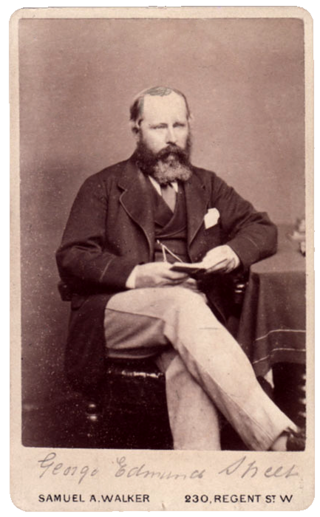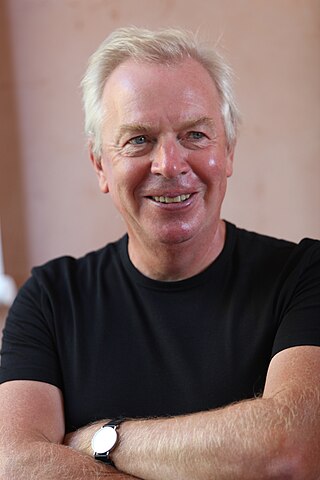
In visual arts, music and other media, minimalism is an art movement that began in post–World War II in Western art, most strongly with American visual arts in the 1960s and early 1970s. Prominent artists associated with minimalism include Donald Judd, Agnes Martin, Dan Flavin, Carl Andre, Robert Morris, Anne Truitt and Frank Stella. The movement is often interpreted as a reaction against abstract expressionism and modernism; it anticipated contemporary postminimal art practices, which extend or reflect on minimalism's original objectives.

Iman Mohamed Abdulmajid, known mononymously as Iman, is a Somali–American model and actress. A muse of the designers Gianni Versace, Thierry Mugler, Calvin Klein, Donna Karan, and Yves Saint Laurent, she is also noted for her philanthropic work. She was married to rock musician David Bowie from 1992 until his death in 2016.

Sir Hugh Maxwell Casson was a British architect. He was also active as an interior designer, as an artist, and as a writer and broadcaster on twentieth-century design. He was the director of architecture for the 1951 Festival of Britain. From 1976 to 1984, he was president of the Royal Academy.

Enric Miralles Moya was a Spanish architect from Barcelona, Catalonia. He graduated from the Barcelona School of Architecture (ETSAB) at the Universitat Politècnica de Catalunya (UPC) in 1978. After establishing his reputation with a number of collaborations with his first wife Carme Pinós, the couple separated in 1991. Miralles later married fellow architect Benedetta Tagliabue, and the two practiced together as EMBT Architects. Miralles' magnum opus and his largest project, the new Scottish Parliament Building, was unfinished at the time of his death.

George Edmund Street, also known as G. E. Street, was an English architect, born at Woodford in Essex. Stylistically, Street was a leading practitioner of the Victorian Gothic Revival. Though mainly an ecclesiastical architect, he is perhaps best known as the designer of the Royal Courts of Justice on the Strand in London.

Sir David Alan Chipperfield, is a British architect. He established David Chipperfield Architects in 1985, which grew into a global architectural practice with offices in London, Berlin, Milan, and Shanghai.

The British School at Rome (BSR) is an interdisciplinary research centre supporting the arts, humanities and architecture.

The Neues Museum is a listed building on the Museum Island in the historic centre of Berlin, Germany. Built from 1843 to 1855 by order of King Frederick William IV of Prussia in Neoclassical and Renaissance Revival styles, it is considered as the major work of Friedrich August Stüler. After suffering damage in World War II and decay in East Germany, it was restored from 1999 to 2009 by David Chipperfield. Currently, the Neues Museum is home to the Ägyptisches Museum, the Papyrussammlung, the Museum für Vor- und Frühgeschichte and parts of the Antikensammlung. As part of the Museum Island complex, the museum was inscribed on the UNESCO World Heritage List in 1999 because of its outstanding architecture and testimony to the evolution of museums as a cultural phenomenon.

Jeffrey Kipnis is an American architectural critic, theorist, designer, film-maker, curator, and educator.
Foreign Office Architects, FOA, was an architectural design studio headed by former husband and wife team Farshid Moussavi and Alejandro Zaera-Polo. The London-based studio, which was established in 1993, specialised in architectural design, master planning and interior design services for both public and private sector clients. Following the end of the couple's marriage, the winding up of the studio's activities was announced in December 2009. The establishment of two new practices, FMA and London/Barcelona based AZPA Limited followed in 2011.
Sauerbruch Hutton is an international agency for architecture, urban planning and design. It was founded in London in 1989 and is now based in Berlin, Germany. The practice is led by Matthias Sauerbruch, Louisa Hutton and Juan Lucas Young.

Luis Ramiro Barragán Morfín was a Mexican architect and engineer. His work has influenced contemporary architects visually and conceptually. Barragán's buildings are frequently visited by international students and professors of architecture. He studied as an engineer in his home town, while undertaking the entirety of additional coursework to obtain the title of architect.
Lynch Architects, formed in 1998 by Patrick Lynch, is a London-based practice. The directors are Patrick Lynch, Claudia Lynch and David Evans. Lynch Architects was awarded the Young Architect of the Year Award from Building Design magazine in 2005, and co-represented Ireland at the 2008 Venice Architecture Biennale. The practice was selected by Sir David Chipperfield to exhibit at the 2012 Biennale.

Andrew David Whalley is an architect registered in the United Kingdom and United States of America. His speciality is ecological design. In 2011, he was named Deputy Chairman of the international architecture firm Grimshaw Architects. He became chairman in 2019.

Sou Fujimoto is a Japanese architect.
Annette Gigon / Mike Guyer Architects is an architectural office based in Zurich, Switzerland. It is led by the Swiss-born architect Annette Gigon and the U.S.-born architect Mike Guyer. Works by the office have been widely published and are admired for their formal logic and legibility, their sensitive handling of materials, and their skillful use of color.
Thomas Vincent Emerson is a British architect based in London and Zürich. His practice, 6a architects, founded with Stephanie Macdonald in 2001 is best known for designing buildings for the arts and education for which it has won several RIBA Awards and the Schelling Medal for architecture. He was appointed Officer of the Order of the British Empire (OBE) in the 2021 New Year Honours for services to architecture and education.

Christian Kerez is a Swiss architect, architectural photographer and a university professor.
British high-tech architecture is a form of high-tech architecture, also known as structural expressionism, a type of late modern architectural style that emerged in the 1970s, incorporating elements of high tech industry and technology into building design. High-tech architecture grew from the modernist style, using new advances in technology and building materials.













